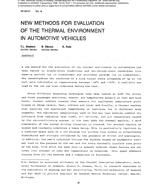
SF-86-01-4 — New Methods for Evaluation of the Thermal Environment in Automotive Vehicles
- Comments Off on SF-86-01-4 — New Methods for Evaluation of the Thermal Environment in Automotive Vehicles
- ASHRAE
A new method for the evaluation of the thermal environment in automobiles has been tested in steady-state conditions and nori-steady-state conditions like warm-up periods (as in-wintertime) and, cool-down periods (as in summertime). The investigation was conducted in a wind tunnel where airspeeds of up to 130 km/h were achievable at temperatures between -18°C and +400C . A realistic sun load on the car was also simulated during the test.
Three different measuring techniques have been tested at both the driver and front passenger positions, namely: air temperature sensors at feet and head level, thermal -comfort sensors that measure the equivalent temperature positioned at three levels, feet, abdomen and head; and finally, a thermal manikin that measures the equivalent temperature or heat-loss for 16 different body segments. The equivalent temperatures used in the two last methods combine the influence from radiation (sun load), air velocity, and air temperature caused by the air-conditioning system. In the test with the thermal manikin, a good simulation of the normal driving situation is created. The thermal manikin is heated and thermally simulates a human being. This is particularly important in a confined space such as a car because the airflow from inlets is nonuniformly distributed and strongly influenced by the presence of driver and passengers. In addition, the sun’s radiation through the windows causes an asymmetric thermal load on the persons in the car and the seats thermally insulate some parts of the body, from which the heat loss is greatly reduced. These factors are not taken into account if only air temperature is measured. This paper presents results from all the methods and a comparison is discussed.
Units: SI
Citation: Symposium, ASHRAE Transactions, 1986, vol. 92, pt. 1B, San Francisco
Product Details
- Published:
- 1986
- Number of Pages:
- 17
- File Size:
- 1 file , 1.4 MB
- Product Code(s):
- D-SF-86-01-4

